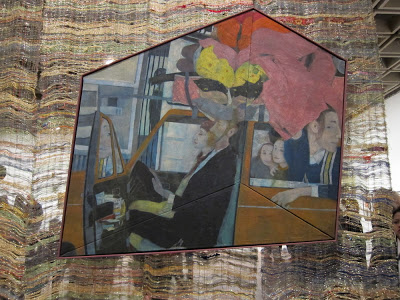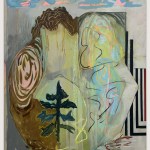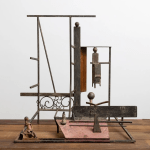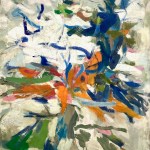The 2012 incarnation of the Whitney Biennial features (in addition to a huge slate of film and video screenings in a side room and performance on the 4th floor) relatively open gallery space with very few wall partitions, lots of small work hung simply around the open space, some creative (but not pretentious) installation strategies, and a smattering of handmade sculptures and low-tech installations throughout. In other words, the 2012 Biennial has adopted a modest DIY aesthetic that you might see at an artist-run gallery in, say, Bushwick.
Overall, I liked the human scale of the objects, the emphasis on the handmade (as opposed to professionally fabricated), and the way painting infused several conceptually driven installations. I have to go back to see the Forest Bess paintings and the video programming, but here are images of a few things that caught my eye on my first visit.
Two of Kai Althoff’s paintings hung loosely on a woven panel (by Travis Josef Meinolf) in the middle of the gallery. The other painting, an oddly shaped, six-sided multipanel piece, was hung close to the floor. Above: Untitled, 2011, oil, synthetic polymer, tempera, and varnish on fabric and silk, 52 � x 57 � inches. Collection of the artist; courtesy Gladstone Gallery, New York.
Nick Mauss (lives in New York, born 1980) curated an installation of small paintings and work on paper from the Whitney’s collection and the Smithsonian Archives of American Art. His mission is to to “derail art historical genealogies” so that we can invent new associations for the art work. I entered Mauss’s “intervention” through the wrong door and was surprised to see that someone was drawing plant forms like Ellsworth Kelly did in the 1960s–oh wait, that IS an Ellsworth Kelly–so I guess I experienced the “spatial, temporal, and psychological shift” that Mauss was after. Above: Marsden Hartley (1877�1943) Madawaska, Acadian Light-Heavy, Third Arrangement, 1940, oil on masonite 27 7/8 x 21 1/2 inches.
Cameron Crawford hung small painting-like objects on a constructed piece that tries to equate art making with useless labor. The wall text is stuck right on one of the objects, perhaps critiquing our incessant need to know. Do we prefer to read wall text rather than trust our own ability to construct meaning by looking closely and making intuitive connections? But I don’t think Crawford had this in mind. The label position makes the piece look like an artifact in a history museum, and it may simply indicate that Crawford values artist’s intent over the viewer’s right to form a personal interpretation. But, of course, artists don’t always know what the work is about. Sometimes years go by before we understand. Above: making water storage revolution making water storage revolution, 2012, poplar, paste wax, plaster, wood filler, oil on string, oil on organza, primed brass, primed steel, graphite and felt-tip pen on muslin, hardware, and hair, 60 x 180 x 12 inches.
Joanna Malinowska included this painting in her installation. Above: Leonard Peltier, Horse Nation, 2011, oil on canvas, collection of the artist; Dorothy Ninham and Leonard Peltier Defense Offense Committee.
A grid grouping of small-scale paintings by Andrew Masullo (lives in San Francisco, born 1957). All oil on canvas. Collection of the artist; courtesy Feature Inc., New York
Performance artist and painter Jutta Koether (lives in New York and Berlin, born 1958) hung her paintings back-to-back on thick sheets of glass. Clustered around one of the odd-shaped windows, the paintings reference Nicolas Poussin�s painting cycle The Four Seasons (1660�64). Koether, who is interested in creating a contemporary context for a traditional medium, wants to challenge her audience to “reconsider the framework through which they see and interpret paintings,” but the installation and text seem overwrought. The light, agitated brushwork, illusive imagery, and art historical reference make the point. Above: The Seasons I, 2011, synthetic polymer and oil on canvas, glass, 67 x 86 3/8 inches. Collection of the artist; courtesy Galerie Buchholz, Berlin
Tom Thayer�s environments feature a little of everything: puppet-like figures, stop-motion collage animations, old portable record players, and, oh yeah, paintings, too, which he calls handmade backdrops. Above: Act VI: The Whelming, 2012, mixed media, 50 x 50 inches. Collection of the artist; courtesy Derek Eller Gallery, New York
While I was there, Nicole Eisenman was giving a talk to a big group of middle
school students. Images about sex, texting, breaking up…naturally,
they were fascinated. Above: Untitled, 201, forty-five mixed-media monotypes, 24 3/4 x 19 3/4 inches. The Hall Collection; courtesy Leo Koenig Inc., New York.
Nicole Eisenman, Breakup, 2011, oil and mixed media on canvas, 56 x 43 inches. Collection of Robert and Bonnie Friedman; courtesy Leo Koenig Inc., New York, and Susanne Vielmetter Los Angeles Projects
Kate Levant (lives in Detroit, born 1983) scavenged the materials for her installation from a burned out house in Detroit. Hung haphazardly from the ceiling with chains and electrical cords, the sheets of foil insulation lining, cardboard, and other decaying materials evoke both the inhumanity of frontier justice and the strange hopefulness of spring cleaning. Above: ‘eyenter “integra intra’ impression, 2011, mixed-media, dimensions variable. Collection of the artist; courtesy Zach Feuer Gallery, New York, and Susanne Hilberry Gallery, Detroit.
Amidst a series of scrapbook-like collages based on the butoh-fu notebooks of Japanese choreographer Tatsumi Hijikata (1928�1986) are a couple of robust paintings by Richard Hawkins (lives in LA, born 1961) that reference Gustave Moreau�s (1826�1898) 1876 painting of the dancer Salome carrying the head of John the Baptist. Above: Salome Painting: Smoke Smoke, 2012, oil on canvas, 32 1/2 x 39 inches. Below: Salome Painting: Icy Balled,
2012, oil on canvas, 16 x 20 inches. Collection of the artist; courtesy
Greene Naftali, New York, and Richard Telles Fine Art, Los Angeles.
2012 Whitney Biennial, curated by Jay Sanders and Elizabeth Sussman. Whitney Museum of American Art, New York, NY. Through May 27, 2012.
Related post:
2012 Whitney Biennial: Long on video and film, short on painting
——-
Subscribe to Two Coats of Paint by email.




































I appreciate your approach, ie "strategies" of painting, installation, etc. While I haven't visited the show yet, you have made me want to.
Sharon,
Thanks for this grouping.Its interesting to see the painting extracted from the rest of the show. There was also a large painting by Art and Language in the basement lounge area. I agree with you about Koether's installation (I would extend it to the pretense of her project in general). The paintings in the show seemed like placeholders for art, like almost all of the other physical works.The forced rhetoric of much of the rationale behind the installations, and most often the installations themselves, seemed incredibly contrived and predictable.
I agree with points made in reference to "contrived" installations. Freestanding or suspending paintings using clever supports, or not so clever supports, confuses everyone.
While I have not seen the show yet, this makes me wonder if the curator felt that painting cannot stand on it's own in the midst of all the other methods, that it must be somehow inserted into other approaches to remain interesting.
great stuff
Looks GOOD!!
Great post, as always. Thank you Sharon.